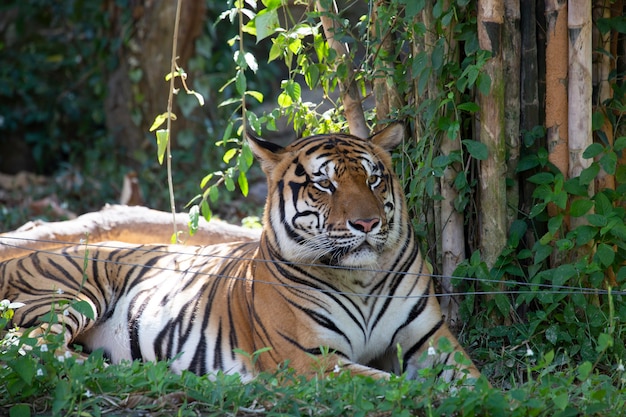Hi everyone, hope your all okay. Today is International Tiger Day, it is an annual global celebration to raise awareness for tigers and is held annually on 29 July. It was first created back in 2010 in St. Petersburg, Russia.
Tigers are beautiful creatures that should be able to live in their own habitat, free to wonder their land, without any worries, but that is not the case. They are becoming increasingly low in population and soon they will become extinct. Tigers are like us in many ways where they protect their family and their homes, it’s when it is being invaded by poachers that they get very territorial.
International Tiger Day is for us to remember our animal kingdom, to do something now to prevent these beautiful animals from dying out.

Facts About Tigers
Tigers are the largest cats on Earth. They can weigh up to 720 pounds (363 kg) and stretch 6 feet (2 meters) long. While not quite as tall as a male lion, a male tiger is heavier and longer.
A tiger’s upper canine is about 4 inches (10 cm) long, which is about the size of a man’s finger.
The earliest tiger fossils are 2 million years old.
The Latin name for the tiger is Panthera Tigris. The word Panthera is from the Greek word meaning “hunter,” while Tigris is an Old Persian word meaning “fast” or “arrow-like.”
A captive tiger can live up to 20 years. Wild tigers live between 10 and 15 years.
Because tigers usually attack their prey from the side or rear, some people living in rural India wear masks on the back of their heads.
Tigers don’t only have striped fur; they also have striped skin.
Tigers have been on earth for a long time. Scientists in China have discovered fossils of tigers that date back to 2 million years.
A tiger’s saliva is an antiseptic. It is useful for cleaning their wounds.

Over the last 150 years, the tigers’ range has shrunk by nearly 95%. There are estimated to be around 3,900 tigers left in the wild.
Tigers were around about 2 million years ago
Tigers are called “hypercarnivores,” which means they live exclusively on meat. Tigers eat cows, bird, monkeys, lizards, crocodiles, and even small elephants. Their digestive systems simply cannot digest fruit, plants, or insects.
The Sumatran tiger is the smallest tiger. A male weighs about 265 pounds (120 kg), which is about the same as a female lion.
A group of tigers is called a streak or an ambush.
Tigers can run as fast as 35 mph, but only for short distances. Most of their prey can outrun them, especially deer and antelope.
A tiger’s tail helps it balance while its running. Its tail can be up to one-third of its body length.
Sumatran tigers are the smallest surviving tiger subspecies on earth.

There are around 30 South China Tiger that’s left in the wild. Although there are still about 70 that’s still left in zoos and special breeding places around China. Experts predict that they may eventually die out because of inbreeding while under captivity.
A tiger’s claws can grow up to 4.7 inches (12 cm) long.
Less than 100 years ago, tigers roamed over much of Central, South, and Southeast Asia and were even found in Turkey. Now, they are found only in parts of South and Southeast Asia, and some pockets in Eastern Russia and China.
The South China Tiger is the rarest tigers in the world
In 1960, over 4,000 South China tigers lived in China. Today, there are fewer than 20 lefts in the wild and just 60 in zoos. They were hunted to near extinction because the government declared they were pests.
The South China tiger has the fewest stripes, while the Sumatran tiger has the most.
A tiger’s back legs are longer than its front legs, which makes it a running, jumping, and pouncing machine.
Female tigers give birth to 2-4 cubs at a time. They can do so every two years.

White tigers are born when two Bengal tigers carrying that specific gene breed together.
The white tiger has a light cream colour with grey and faint brown stripes. Its nose is pink.
Their eyes are usually blue, but they can also be amber or green too.
White Bengal tigers are most likely extinct in the wild, but are still live-in zoos. All captive white tigers can be traced to one wild white tiger named Mohan, who was captured in India in 1951.
A white tiger lives between 10 and 20 years.
Sadly, no white tigers are left in the wild. All the white tigers in the world are now in captivity.
The first recorded sight of a white tiger was in between 48-1000AD.
The white tiger is a rare type of Bengal tiger with a unique gene. This unique gene gives them the white colour.
Bengal tigers are the least endangered of the tigers, with approximately 2,000 left in the world.
The average number of cubs born to get one healthy white tiger cub exhibitors want is 1 in 30. The other 29 cubs can typically be born deformed, or they’re considered the wrong colour and euthanized, or they die shortly after birth due to genetic defects.
The Bengal (or Indian) tiger is the best-known of all the tigers. Shere Khan in the movie The Jungle Book is a Bengal tiger.
The Bengal tiger, also known as the Royal Bengal tiger. They inhabit the forests and mangrove swamps of India, Burma, Bangladesh, Bhutan, and Nepal. They are excellent swimmers, tigers are probably the most water-loving of the felines. The Sumatran tiger has webbed feet, which makes it an especially skilled swimmer.
Just 100 years ago, over 40,000 Bengal tigers roamed India’s forests, but now there are less than 1,400. Poaching and loss of habitat are their primary threats.
A tiger’s night vision is 6 times better than a human.
Contrary to the belief, tigers do not attack humans if they can satisfy their hunger. Some of the man-eating tigers are either old or have no teeth to hunt.
A tiger spends about 18 hours a day sleeping.

Siberian tigers, living in the wild, can survive around 15 years, they are the biggest of all the tigers.
The vocal repertoire of tigers is vast, they grunt, growl, roar, moan, snarl, chuff, hiss, and gasp. It’s thought that each vocalisation is used to communicate different things.
A Siberian tiger has almost 20,000 hairs per square inch, or about 3,000 hairs in a single sq. cm of skin.
The Siberian tiger has fewer stripes than the Bengal tiger, and its stripes are brown rather than black.
One hundred years ago, there were eight different subspecies of tiger. Today, three of those subspecies are extinct and others are dangerously close to being wiped off the earth forever.
Despite conservation efforts, the Siberian tiger could become extinct in the wild in the next ten years.
Siberian tigers, also known as Amur tigers, are the world’s largest cats.
Tigers do not live-in groups, except for the tigress with her cubs. They usually roam across vast areas, which are known as their “home ranges.” The size of their home range depends on the availability of food.

Tigers cannot purr. When they are happy or feel safe, they squint or close their eyes.
The Malayan tiger is critically endangered as there are no more than 300 left in the world. These tigers are either poached by humans for their skin, teeth and more. Besides that, their tropical forest habitat is being lost to deforestation and land development.
Tigers have soft toe pads which help them walk silently through their habitat. A tiger will typically travel 6-12 miles during a night’s hunting.
The tiger is the national animal of both India and Bangladesh.
According to ancient Chinese belief, a tiger’s body parts have magical powers to cure disease. Tiger bones supposedly cure weakness; whiskers are used for toothaches; and tiger tails are used for skin diseases. These long-held beliefs fuel catastrophic tiger poaching.
There are almost as many tigers living in zoos and wildlife parks as there are in the wild.
Over the past one hundred years, over 95% of the tiger population has disappeared, leaving just 5,000 tigers in the world today. Their population is still decreasing due to poaching and habitat loss.

There are about 350 Indochinese tigers left in the world today. The low population is down to poaching and the loss of their habitat.
Black (melanistic) tigers do exist, though none live in captivity.
Scientists believe that the white spots behind the ears of a tiger help tiger cubs follow their mothers through the shady forest. The white spot is called an “ocelli.”
A tiger’s roar can be heard over 2 miles (3 km) through a forest.
The Bali tiger was purposely hunted to extinction in Bali because it was viewed as evil. The Javan tiger and Caspian tigers were also hunted to extinction.
Nearly 50% of tiger cubs die before they reach one year old, often because their mothers have been shot.
A tiger’s paw print is called a “pug mark.”
Domestic cats share about 95.6% of their DNA with tigers, from which they diverged on the evolutionary tree approximately 10.8 million years ago.
Tigers have the largest brain of any carnivore, except the polar bear.
Charities to Donate
if you are interested in helping these tigers and want to help keep them from extinction, here are some charities you can donate to.
WWF
WCS
Born Free
Rainforest Action Network
Fauna and Flora International
Thank you for taking the time to read my blog, Stay safe and enjoy the rest of your week.

